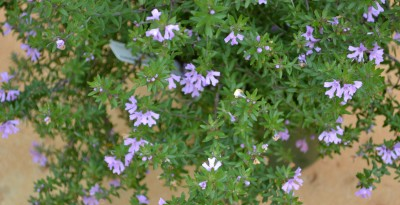Westringia Blue Gem commonly known as Westringia Fruticosa “Blue Gem” is an evergreen plant that has thick greyish blue leaves. Westringia fruticosa ‘Blue Gem’ is a perennial shrub with rosemary-like thick blue-greyish leaves. It is a low-maintenance plant with an elegant appearance. There are lots of vibrant bluish-purple flowers on this plant. The flowers of this plant bloom abundantly in spring. It is a great option for poolside and coastal plantings because of its salt tolerance ability.
Westringia Blue Gem belongs to the family of mint. This delicate westringia mint is a native Australian shrub. It can be used to fill barren flowerbeds, enhance hedges, or add beauty to the gardens. Westringia is a favorite shrub of gardeners and flower lovers across the country because it is easy to grow and it blooms often.
It has the most attractive-looking purple-blue flowers in contrast with the thin grey-green foliage. It has a bushy growth habit and it appears as a dense bush. The shape of this plant is suitable for hedge pruning. It gives a very positive response to this type of pruning. These plants have a feature of mass plantings. The hedges are pruned once a year for producing masses of beautiful flowers. These plants are also found in native gardens and are very easy to maintain.
Westringia Blue Gem Size and Height
The size of this Australian native plant is 1-1.5m high x 80cm-1.3m wide with the planting density of 1-3 plants per m² or 1-2 plants per linear meter. This low-maintenance mint can thrive in a variety of environments. This Blue Gem is a tough evergreen shrub, it can withstand 25 degrees Fahrenheit or even lower than this, possibly as low as 18 degrees Fahrenheit for short periods of time.
Westringia Blue Gem grows 4 to 6 feet tall by 3 to 4 feet wide and has small 3/4 inch long olive-green leaves on dark maroon-brown stalks. The size and shape of this plant are considered ideal features for pruning.
Westringia Blue Gem Problems
Westringia is an extremely resilient plant with few reported pests or difficulties. One of the most common problems is wet feet, so it is important to make sure that these plants have adequate drainage. This plant cannot flourish in gardens that have heavy clay soils and are mostly wet. This wetness can cause certain fungal infections that can become a hurdle in the growth of this plant.
Westringia Blue Gem Growth
Westringias are mostly grown in Australia and have a strong tolerance for a variety of weathers, including drought, cold, and frost, as well as humid environments. Westringia is native to coastal cliffs and thrives in all coastal habitats. The requirements for the growth of these plants include:
- Full Sunlight.
- Little Watering.
- Well-drained Soil.
- Sandy Soil.
Westringias can also grow in partially shady and coastal areas. It is important to consider all the growth requirements before planting Westringia. Although it is easy to grow, certain things such as temperature, watering, and pruning requirements must be maintained by the gardeners.
Westringia Blue Gem Care
Westringia Blue Gem is a shrub that can withstand heat, humidity, and frost. It is an excellent example of massive plantings. It is perfect for native flower gardens. It should not be planted in heavy clay gardens. This plant should not be grown in a garden that is frequently wet or moist.
Westringia Blue Gem grows in direct sunlight to light shade and requires watering infrequently to rarely. This plant, like other Westringia cultivars, is tolerant of a wide range of soils and environmental conditions, such as inland heat, humidity, coastal exposure, and drought. It can be retained as a smaller shrub if pruned once or twice a year.
This Australian native bush requires water for 8-13 weeks until established. It is planted in a well-mulched garden. It is pruned 1-3 times yearly. The soil should be checked before plantation. The varieties of pests may develop in the plant if it is exposed to wet soil. the gardeners should carefully choose the soil or planting place for this shrub.
Westringia Blue Gem’s foliage becomes tidier and denser with regular pruning. After flowering has stopped, prune the tips of the plant to encourage significant growth. In windy places, pruning at the top of the plant is very important to keep it from becoming heavy. The growth of new shoots from the middle of the plant is encouraged by trimming the old-growth every third year.



